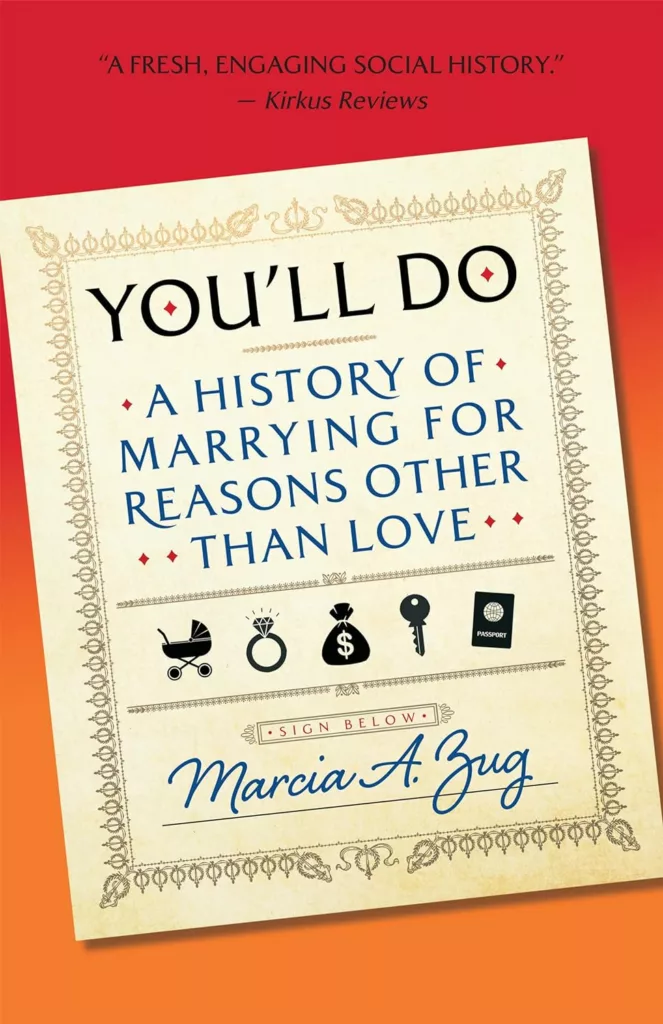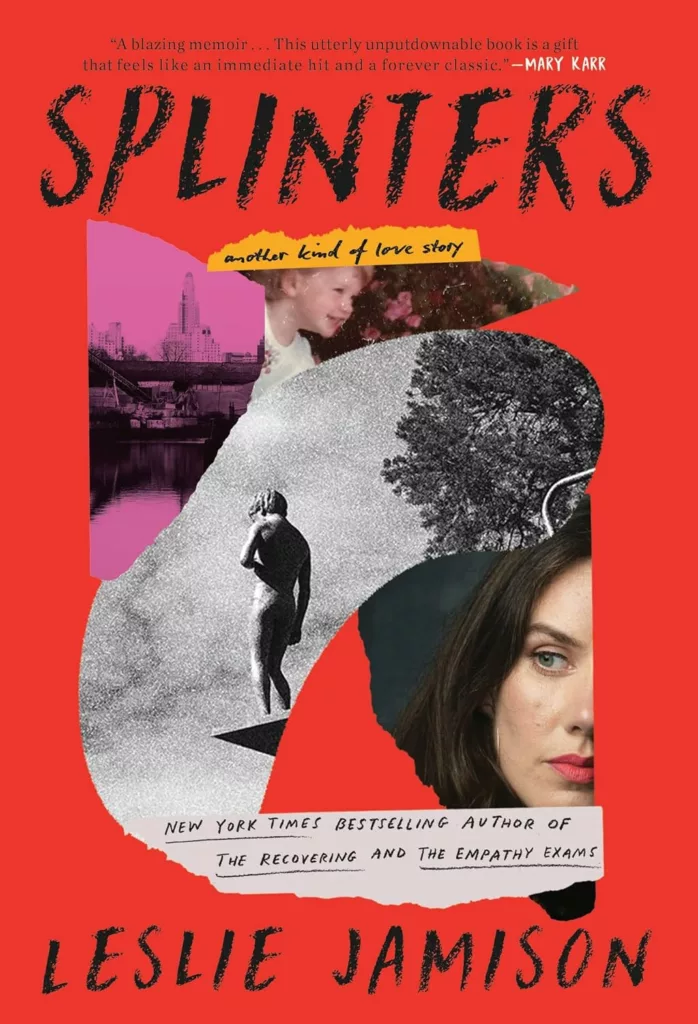
Along with enticing images of gowns, news about celebrity weddings, and tips for choosing rings, a recent issue of Brides magazine offered “65 Happy Marriage Quotes that Will Inspire Every Couple.” The quotations, by Elizabeth Barrett Browning and Justin Timberlake, George Clooney and Alfred, Lord Tennyson, among scores of others, celebrate love, romance, and the enduring happiness that marriage can bestow. “Be married to your best friend,” Sting advises, for example. Brides suggests that one or two of these remarks might be included in marriage vows.
As Marcia Zug, a family law professor at the University of South Carolina School of Law, makes abundantly clear in You’ll Do, her astute, well-researched history of marriage, the idea of love as the essential requisite for marriage is a fairly recent phenomenon, and one with many exceptions. Before the late nineteenth century, when non-love matches fell into cultural disfavor, a marriage was more likely to be transactional: for money, land, or legal status, to facilitate immigration, or even to evade criminal punishment. These “instrumental” reasons persist: “I have a neighbor who married to lower his university tuition,” Zug writes, “two friends who married for tax breaks, and a colleague who married for a green card.”
In early America, marriage could be a beneficial bargain for women. With no right to own property and few opportunities to earn a living, women traded housekeeping and childrearing for economic support. As Zug discovered, financial exigency sometimes led to odd coupling: very young women, for example, advertised their availability to elderly war veterans who were living on their army pensions. After the Widows’ Pension Act was passed in 1836, the prospect became even more appealing.
Marital bargains served men, too, and not only by providing them with a homemaker. Married men gained political rights denied to single males, who were seen as “irresponsible and potentially dangerous.” As Americans moved west, homesteading was easier, and frontier communities more stable, when they were populated by married couples. Sometimes those couples resulted from marriages between Native women and white men who coveted the landholdings retained by Native tribes. Although derided as “squaw men,” they grew wealthy on tribal resources.
Marital bargains attracted immigrants seeking refuge. By marrying, they could circumvent racist and xenophobic exclusionary laws against Asians, Jews, and other undesirables. Single women trying to emigrate were turned away as likely prostitutes. They needed a husband to justify them as acceptable.
Marriage is “a Band-Aid that Americans have used when society is too sexist, too racist, or just too lazy to implement better solutions.”
Marriages between unequal partners—Natives and whites, immigrants and citizens, women shut out of the labor force and the men they hope will support them—carry risk of exploitation and domestic violence, from which the criminal justice system has offered little protection for women and children. Married abusers, Zug found, historically have received lesser penalties than unmarried abusers. Instead of facing punishment, husbands have been shielded from prosecution for rape and even murder. Family courts encouraged reconciliation. As Zug examines the connection between marriage and legal rights, she emphasizes the needs of individuals made vulnerable by lack of resources or opportunities. For them, she argues, marriage is “a Band-Aid that Americans have used when society is too sexist, too racist, or just too lazy to implement better solutions.” When the government enacts pro-marriage welfare reforms, such as, for example, stipulating that low-income women must be married in order to receive benefits, “it is abdicating its responsibility for solving the problems that contribute to female poverty in the first place.” She implies, then, that if low-income women could find better jobs or receive government support, thereby achieving some meaningful independence, they would not be compelled to marry.

Primarily interested in the economic, social, and political factors involved in marital bargains, Zug pushes emotional needs and desires—companionship, personal fulfillment, and certainly the frothy romance celebrated in Brides—to the periphery. Yet such desires create other vulnerabilities, as Leslie Jamison reveals in her frank, soul-baring memoir about love—filial, maternal, and, above all, marital.
Falling in love with her husband—Jamison calls him C—was “encompassing, consuming, life-expanding.” But the two struggled with problems that sent them to couples therapy for years. She hoped that having a baby “would force us to find a better version of our relationship.” Instead, the birth of a daughter made things worse. “It felt,” she writes, “like everything I did or loved was somehow an offense to him.” C claimed he felt isolated by her intense connection to the infant. Her mother came to help, and the three of them—Jamison, her mother, and the baby—formed a tight family unit that C found impenetrable.
Her connection to her child deeply affected her decision to leave C. Jamison suffered as a daughter of divorced parents who had little contact with her father, and she fears reproducing that pain in her daughter’s life. She asks her friends for advice, she ruminates, she tries to convince herself that leaving is her best and only choice. “The rise of the no-fault divorce,” she thinks, “suggested that you didn’t need a justification for ending a marriage beyond the desire to be happier.” But she feels guilt, and loss.
Although ending her marriage leaves her “dripping with love,” her rapturous adoration of her daughter isn’t enough. She wants to be married. She daydreams about being “desired by some powerful man.” She wants to fall in love again; she feels a primal need “to be taken care of.” She yearns “for a partnership in which it felt easier to take care of each other, to access that part of myself that knew how to accept help, and offer it.”
Her desire for a caring partner stems in part from the unrelenting, often isolating experience of single parenting. Even when she and C start to share custody of their daughter, she feels burdened by caregiving, teaching full-time, writing, and publicizing her latest book, The Recovering, about her years as an alcoholic. The book, she admits, essentially is about “the only thing I ever wrote about”: “the great emptiness inside, the space I’d tried to fill with booze and sex and love and recovery and now, perhaps, with motherhood.” That feeling of great emptiness is the through line of this memoir, as well. Motherhood, the embracing love of her own mother, and even accolades from the literary world fail to assuage an abiding, unsatisfied hunger for proof of her self-worth. As a child, when her father expressed disappointment over a grade in a history class, she made a decision: “Whatever the opposite of getting a B− was, I would spend the rest of my life doing that.” When she first met C, a widower grieving his wife’s death from cancer, she thought, “Making this man happy would be more meaningful than anything else I’d ever done.” In the end, she hadn’t made C happy; she’d gotten another B−. “If I’d failed at happiness,” she writes, “then success seemed like a consolation prize.” She needs a man’s validation to justify her existence.
Jamison’s quest for love that ends in marriage leads her to affairs with some wildly inappropriate men: there’s a rambler who calls himself a “professional tumbleweed” and keeps telling her he’s not marriageable material. Still, she fantasizes. And there’s a man she calls the “ex-philosopher,” who’s critical and remote. Still, she hopes. “There was something nearly religious about the way I worshiped long-term marriage,” she confesses. At an electronica festival where she’s been invited to talk about narcissism and empathy, Jamison meets a writer who shares a “long saga” about her open relationship. The writer insists she’ll never marry, and Jamison wonders about that. “On the surface,” she sees, “we were talking about two very different ways to be a woman—married with a child, and childless with many lovers. But underneath I think we were both talking about ways to find relief from living trapped inside ourselves. We were both looking for the freedom that lay on the other side of surrendering control.”
One marital bargain that Zug reports, but doesn’t elaborate on, was made between her great-aunt Rosie and a man she had never met. Rosie, a Jewish factory worker in New York, went to Poland in 1937, following the news of Nazi persecution of Jews, to marry her best friend’s brother, Sol. He would have perished if she hadn’t brought him to America as her husband. She and Sol had a daughter. They fell in love.
For Zug, Rosie’s story exemplifies marriage as “fundamentally a legal institution. It is a way to confer valuable rights and benefits, and sometimes it is the only way to receive these rewards.” Zug doesn’t tell us what led to Rosie’s decision to rescue Sol from the Nazis. It may have been motivated purely by altruism. Or maybe Rosie was trying to prove her worth, or to find relief from living trapped inside herself, or to escape a future she didn’t want. Just as Sol reinvented himself as American, Rosie reinvented herself, too. They made a bargain. Jamison, I suspect, would approve.

